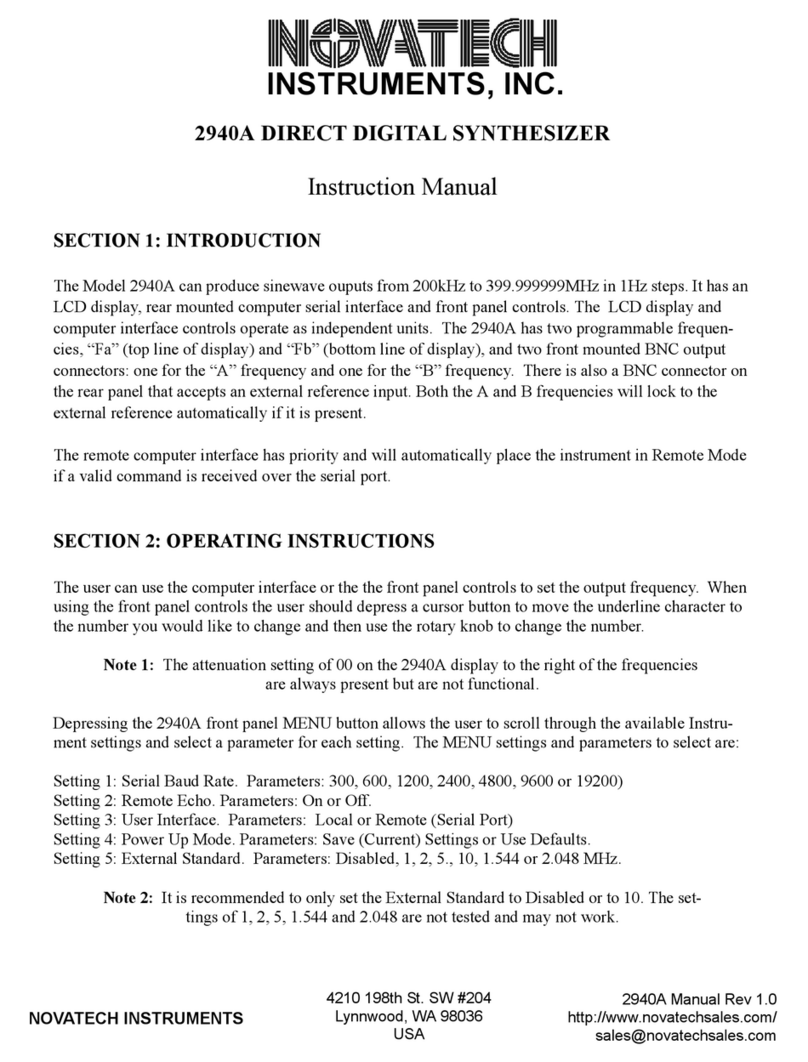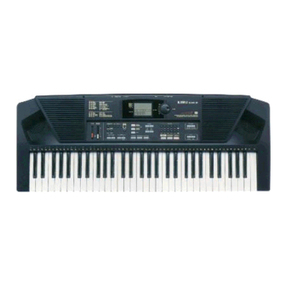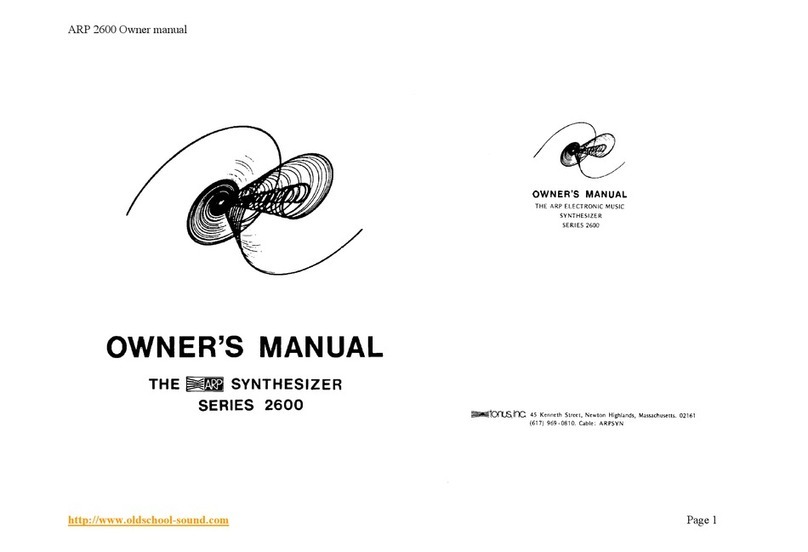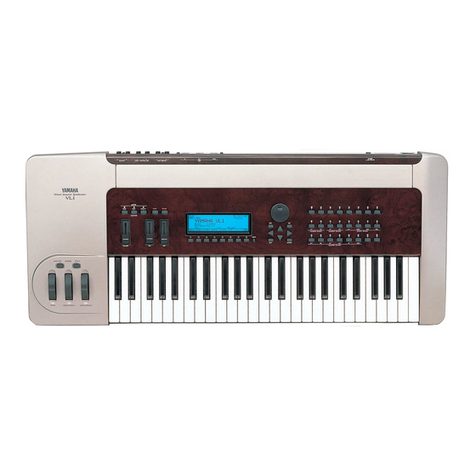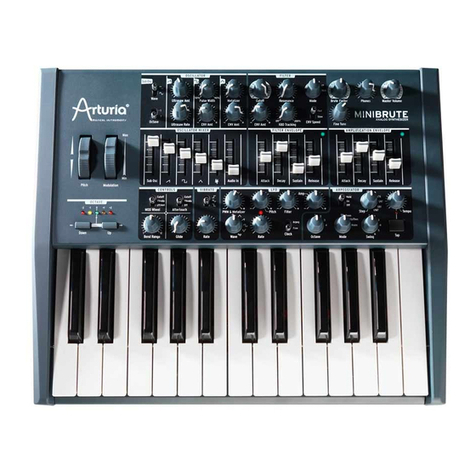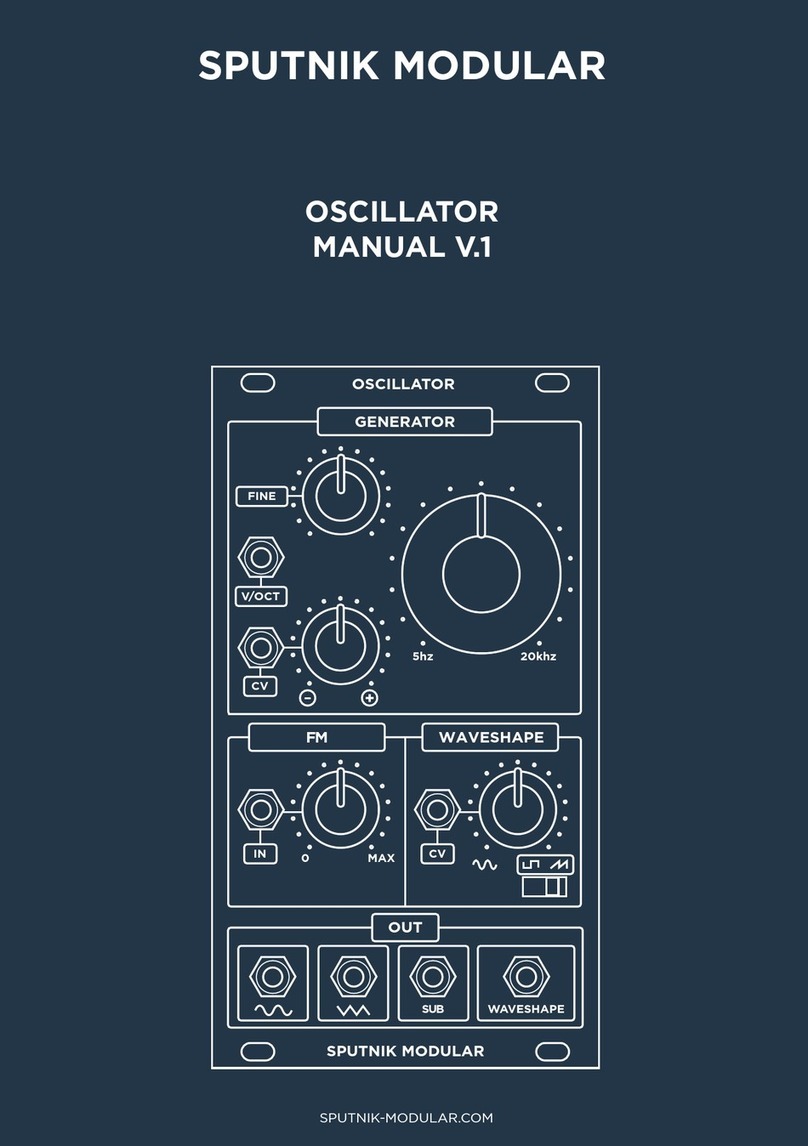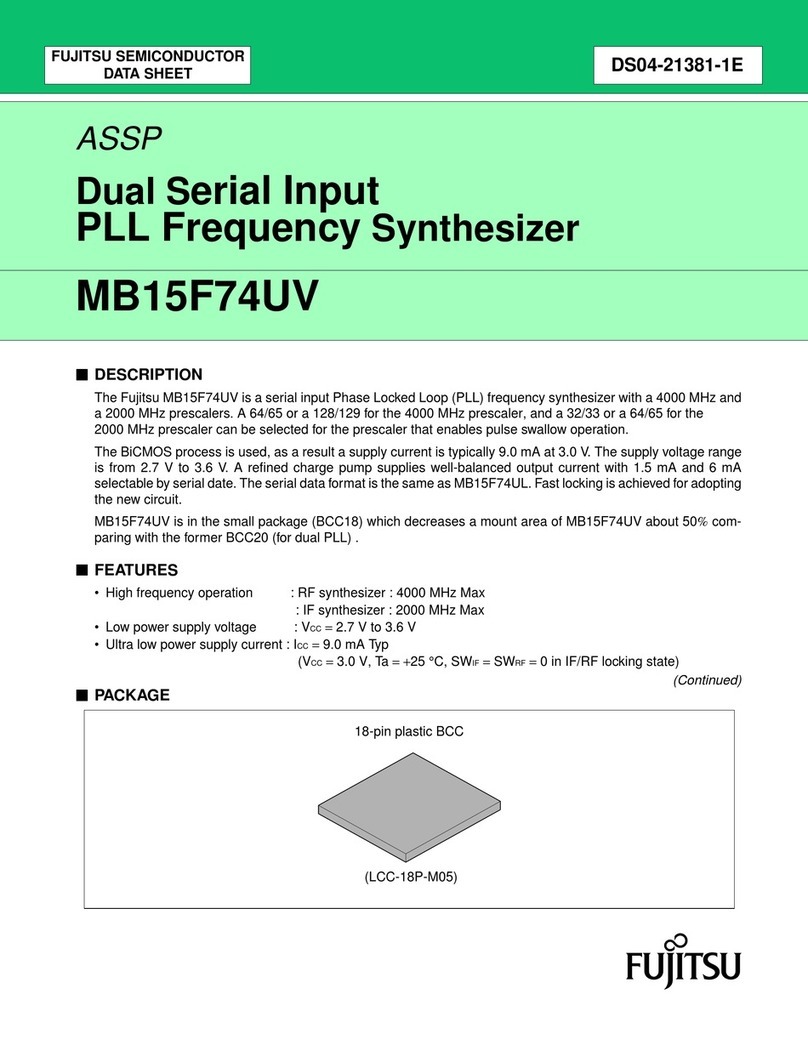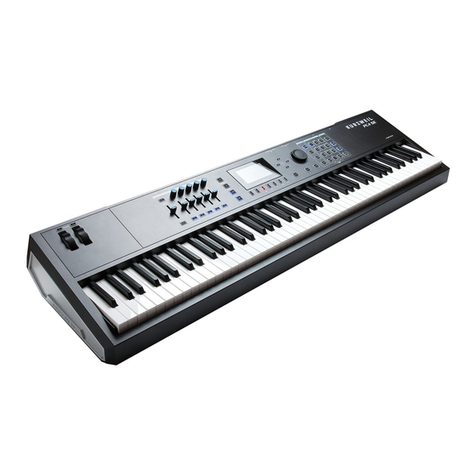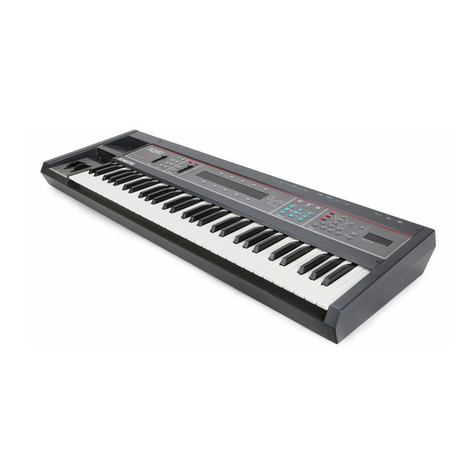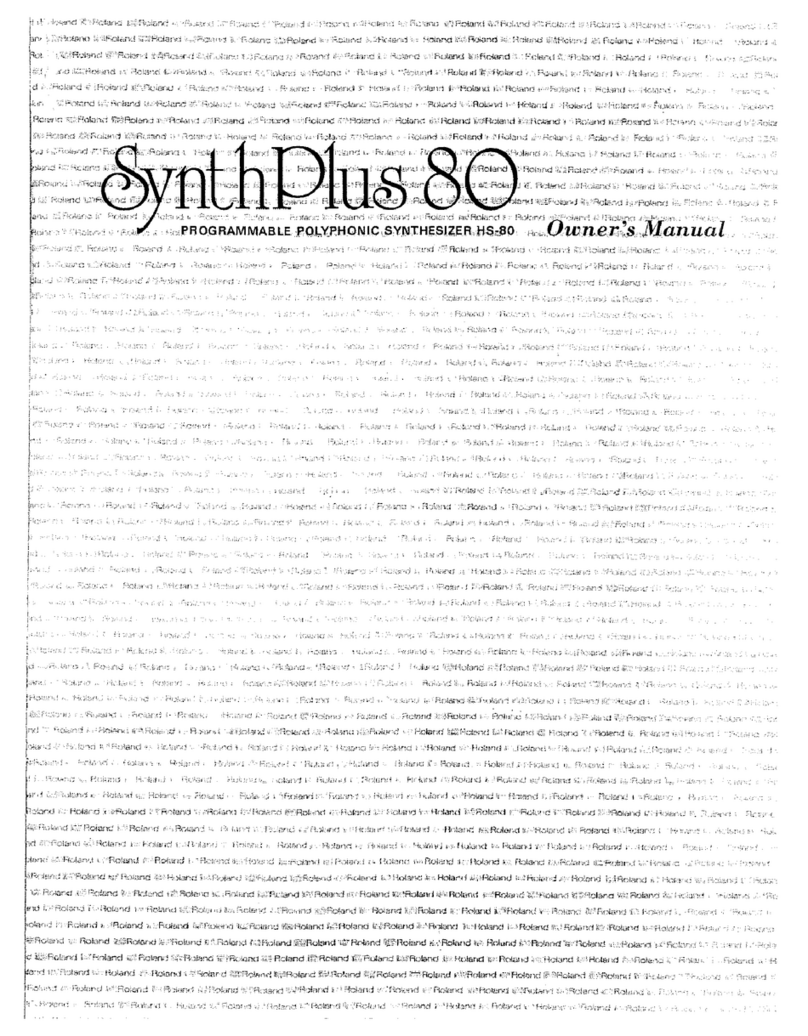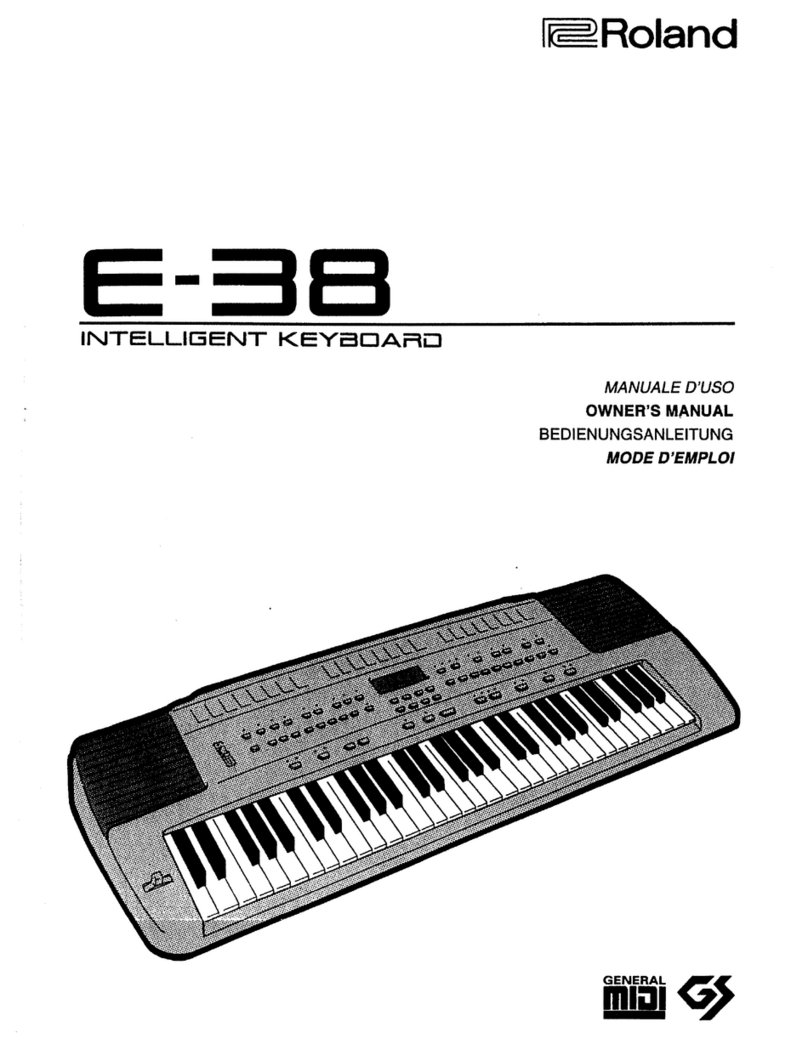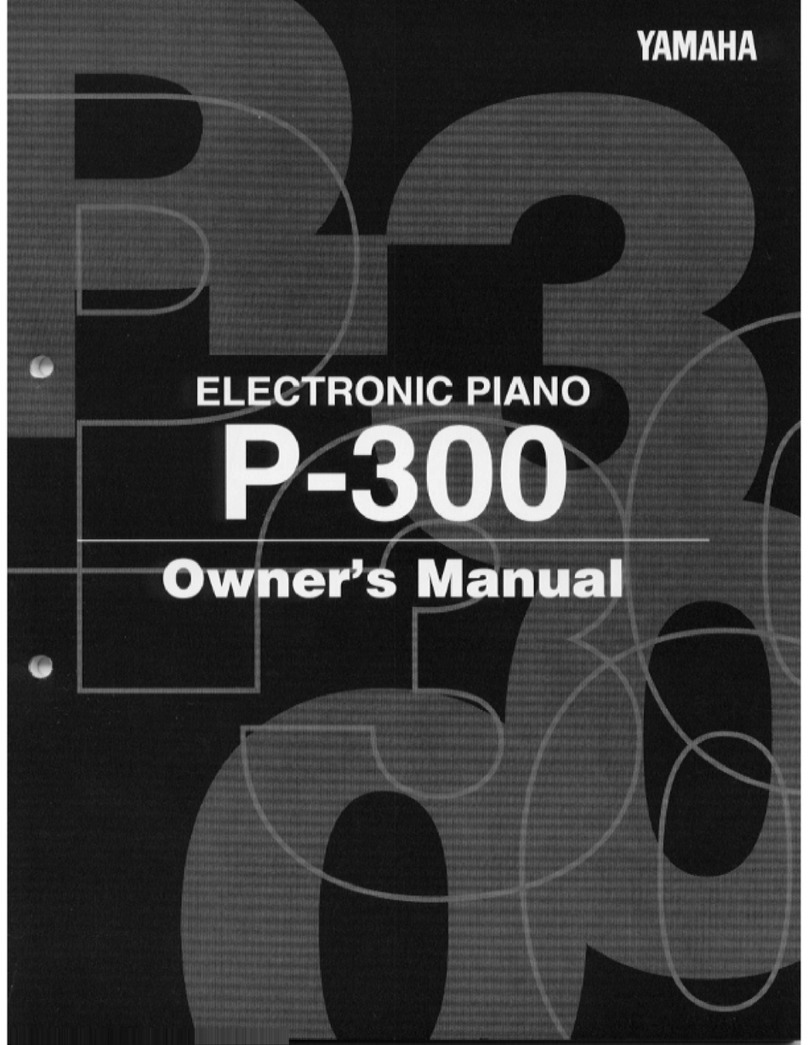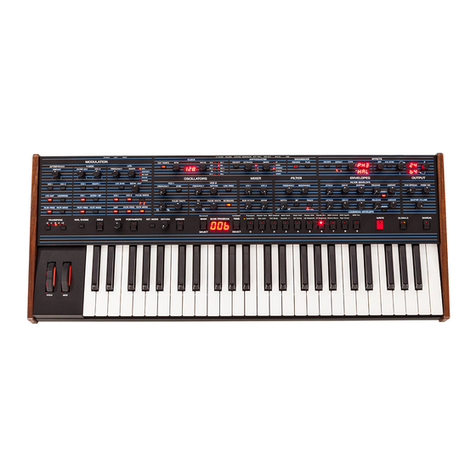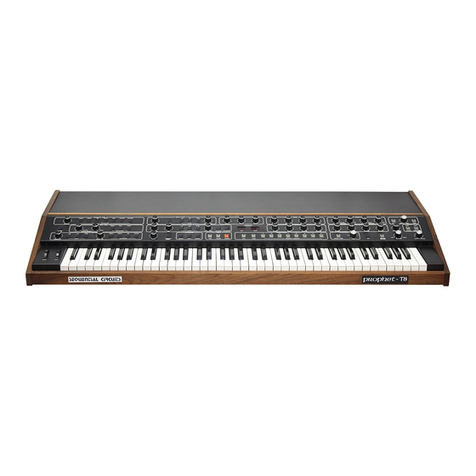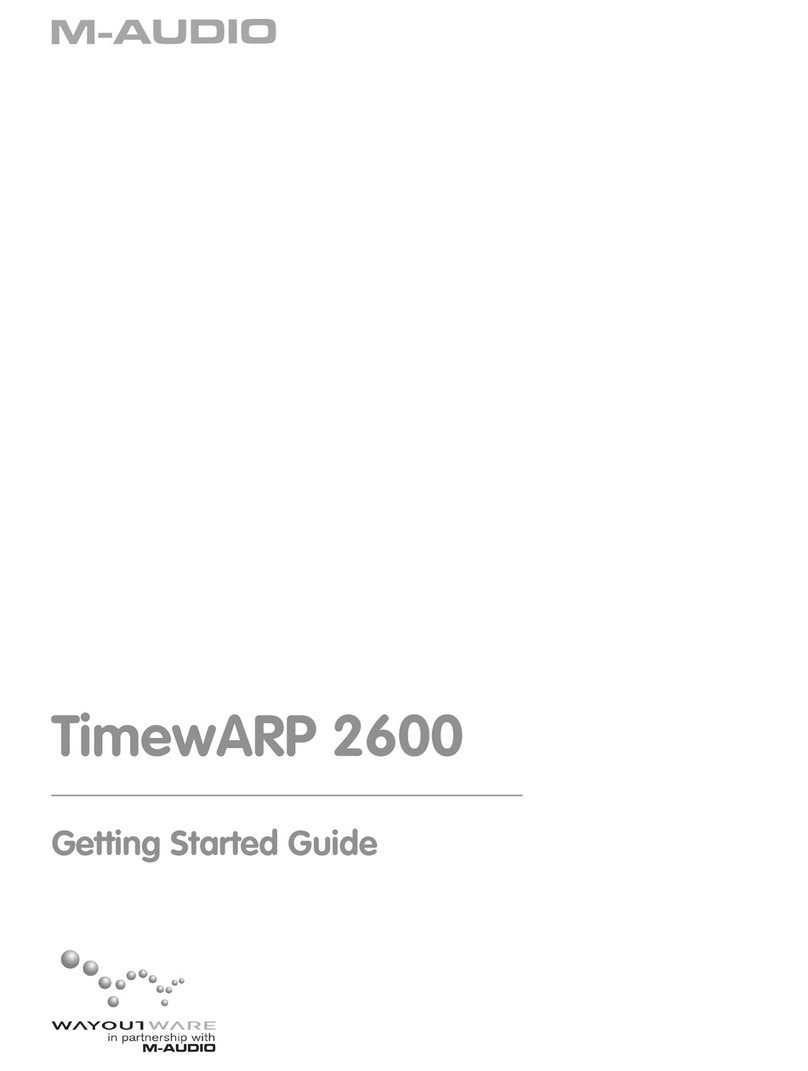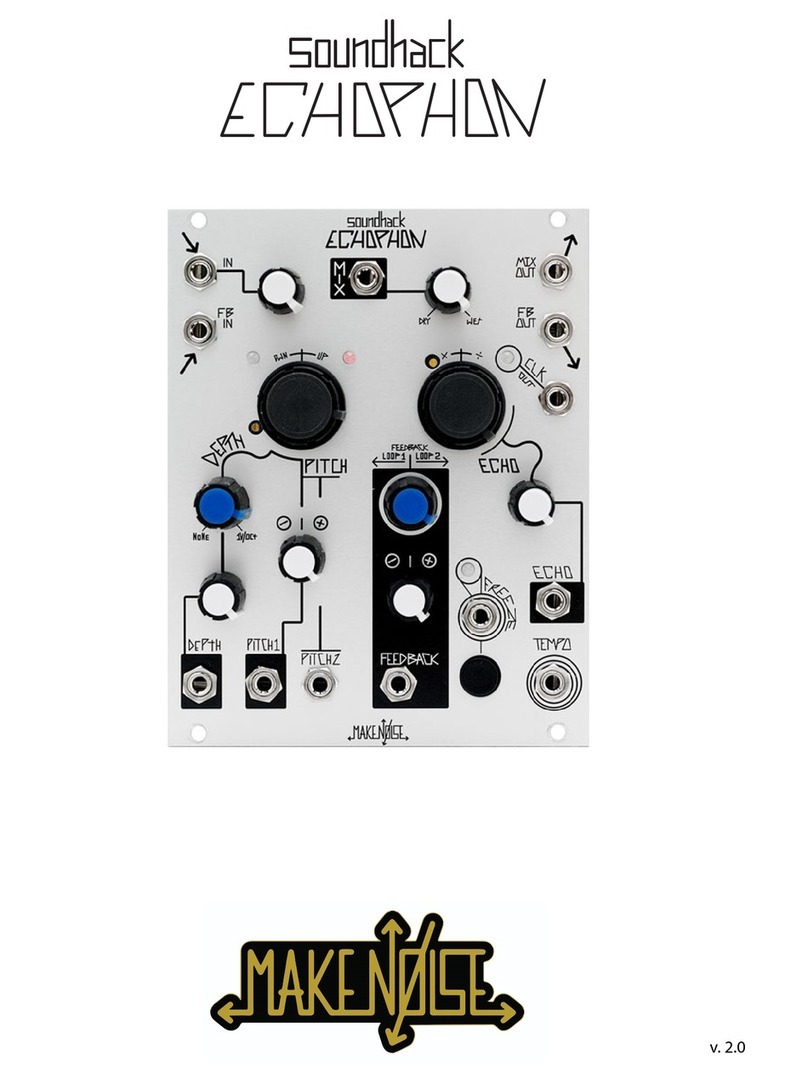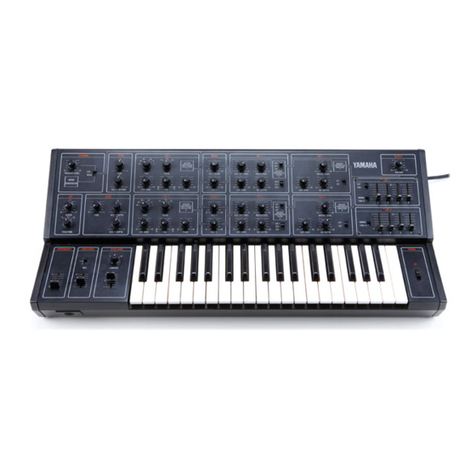Novatech Instruments 1450A/02-AH User manual

1450A/02-AH Manual
1/10
Copyright 2003 Novatech Instruments, Inc.
10/5/2005
MODEL 1450A/02-AH Synthesizer
NOTE:
This is a preliminary manual for the Novatech Instruments, Inc. Model 1450A/02-AH
Synthesizer.
WARNING:
Live line voltages are exposed internal to the instrument.
Do not operate with covers
removed. Disconnect power cord before opening instrument for any reason.
Specifications:
OUTPUTS:
There are up to nine DDS8p synthesizers internal to the 1450A/02-AH. The output
frequency range of each is 10kHz to 120MHz, ACMOS, in 1µHz steps per LSB on the parallel
interface. Outputs are SMA female on rear panel, 50Ω. See below for operating modes.
INPUT:
External Clock, 10MHz
±
5ppm, >1Vrms, 50Ω. Circuitry detects, locks to and tracks this
input when present. An internal TCXO (10MHz
±
2ppm) is used if the 10MHz external clock input is
left unconnected. SMA Female.
PHASE and FREQUENCY CONTROL:
The Parallel interface is on a 90-pin EDAC 516-series
connector receptacle on the rear panel. An adapter board for use with ribbon cables is available. See
below for connector details.
SIZE:
19inch 2U rackmount case with mounting ears, 16inches deep, not including connectors.
POWER:
120/240VAC, 50/60Hz, <75VA.
ENVIRONMENTAL:
Intended for laboratory/central office environment of: +5oC to +40oC with
humidity 80% to 31oC, decreasing linearly to 50% at 40oC.
OPERATION:
Illuminated front panel power switch. Rear panel mode select switch. Front panel
“IN LOCK” and “POWER OK” LEDs.
Installation Notes:
The 1450A/02-AH contains up to nine independent synthesizers addressable through the various
control signals on the parallel interface connector.

1450A/02-AH Manual
2/10
Copyright 2003 Novatech Instruments, Inc.
10/5/2005
See signal description, timing diagram, timing table and signal notes below for operation.
REAR PANEL CONTROL receptacle
EDAC
PIN
Function
EDAC PIN
Function
EDAC
PIN
Function
A
Frequency Bit0
(FB0) (LSB)
AK
FB30
BU
PB12
B
FB1
AL
FB31
BV
PB13 (MSB)
C
FB2
AM
FB32
BW
RESERVED
D
FB3
AN
FB33
BX
RESERVED
E
FB4
AP
FB34
BY
RESERVED
F
FB5
AR
FB35
BZ
RESERVED
H
FB6
AS
FB36
CA
RESERVED
J
FB7
AT
FB37
CB
RESERVED
K
FB8
AU
FB38
CC
RESERVED
L
FB9
AV
FB39
CD
RESERVED
M
FB10
AW
FB40
CE
RESERVED
N
FB11
AX
FB41
CF
RESERVED
P
FB12
AY
FB42
CH
RESERVED
R
FB13
AZ
FB43
CJ
RESERVED
S
FB14
BA
FB44
CK
RESERVED
T
FB15
BB
FB45
CL
RESERVED (RAC)
U
FB16
BC
FB46
CM
RESERVED (PFR)
V
FB17
BD
FB47 (MSB)
CN
Phase/Freq
Strobe0 (PF0)
W
FB18
BE
Phase Bit0 (PB0)
(LSB)
CP
PF1
X
FB19
BF
PB1
CR
PF2
Y
FB20
BH
PB2
CS
PF3
Z
FB21
BJ
PB3
CT
PF4
AA
FB22
BK
PB4
CU
PF5
AB
FB23
BL
PB5
CV
PF6
AC
FB24
BM
PB6
CW
PF7
AD
FB25
BN
PB7
CX
RESERVED
(MODE)

1450A/02-AH Manual
3/10
Copyright 2003 Novatech Instruments, Inc.
10/5/2005
Parallel Input Requirements
NOTE:
The control inputs are protected against ESD damage by 100Ωseries termination resistors (typically
±
2kV, Human Body Model.
±
200V, machine model).
The inputs on the 1450A/02-AH are 3.3V and 5.0V CMOS logic tolerant.
NOTE:
The connector used on the rear panel is an EDAC 516-090-520-302 receptacle.
All of the inputs,
FB0-47, PB0-13, PF0-7, CFS
and
MR-
, are VHCMOS, TTL and 5V CMOS
compatible and require:
Vil <= 0.8V (Iload < -1.0mA)
Vih >= 2.4V (Iload < 1.0mA)
Cin on each pin is approximately 15pF (application cable capacitance not included). All the input pins
are pulled to the +5V internal V
cc
via pull-up resistors (approximately 4.7kΩ). They are series
terminated with a resistance of 100Ωto prevent reflections and ringing. You may need to supply
source termination resistors for your control signals, depending upon your cabling. The exact value
will be determined by your application.
Reserved pins must be left unconnected, except as noted here. Three control pins are available: RAC,
PFR and MODE. RAC is used to
R
eset
AC
cumulators in the internal synthesizers and is used during
factory test. PFR operates exactly like all the PFn lines, except it controls the reference synthesizer.
This allows each of the nine synthesizers to be used independently if desired. MODE can be used to
select Synchronous or Independent mode without using the switch. If used, it overrides the switch.
Normally left unconnected. (the rear panel switch must be left in the SYNC position if the MODE
line is used).
Signal Descriptions (INDEPENDENT MODE):
The Independent Mode allows each of the internal eight (nine, if PFR is used) synthesizers to be used
AE
FB26
BP
PB8
CY
MR- (Factory)
AF
FB27
BR
PB9
CZ
Common Freq.
Strobe (CFS)
AH
FB28
BS
PB10
DA
BUSY
AJ
FB29
BT
PB11
DB
Signal Ground
(SG)
REAR PANEL CONTROL receptacle
EDAC
PIN
Function
EDAC PIN
Function
EDAC
PIN
Function

1450A/02-AH Manual
4/10
Copyright 2003 Novatech Instruments, Inc.
10/5/2005
at independent frequencies and timing. Phase is not controlled in this mode.
FB0
through
FB47
are the 48 binary frequency data bits presented to the internal DDS. The
frequency output will have 1µHz of resolution per LSB. Since there is no error checking of the user
input, care must be taken ensure that the binary value does not select a frequency output greater than
approximately 120MHz.
PB0
through
PB13.
Since the frequency and operation of each synthesizer is independent in this
mode, the Phase value on the lines PB0 through PB13 are “don’t care.” It is suggested that they be
held LOW in this mode.
Any
PF0-7
going LOW is used to signal the on-board circuitry to load a new frequency into the
corresponding DDS registers. The negative edge of PF is latched, inverted and presented on the
BUSY line. The negative edge also transfers data from the user application connection to internal
latches. Data must be stable at least 25ns before the negative edge of PF. During BUSY, all
appropriate registers on the selected internal DDS8p are programmed and upon completion of the
loading process a new frequency is available at the output. The on-board circuitry takes
approximately 170ns to set the new frequency after BUSY has returned LOW. The timing of BUSY
returning LOW may have several internal clock cycles of ambiguity due to timing re-synchronization
internal to the parallel interface board (
±
200ns). Each separate output is set on PF0-7 going low. The
other unselected synthesizer outputs remain unchanged.
NOTE:
The delay DDS outputs on the rear of the 1450A/02-AH are numbered beginning with “1.” PF0
controls output #1, while PF1 controls output #2 and so on. The Reference DDS is controlled by PFR.
BUSY
is a VHCMOS compatible
output
with:
Voh >= 3.0 V (Iload <= -100µA)
Vol <= 0.4V (Iload <= 100µA)
BUSY
going HIGH indicates that parallel data is being loaded into the DDS circuitry. The output
frequency is updated approximately 170ns after BUSY returns LOW. Please refer to timing diagram
for details.
BUSY
has a source resistance of approximately 100Ω to prevent damage due to accidental shorts. If
this output is used for handshaking, be sure to account for capacitive loading on this signal.
CFS
is not used in this mode and must be held HIGH, or left open (internal pull-up).
Please refer to the timing diagram and table below for the details of setting frequency on the parallel
interface in the independent mode.

1450A/02-AH Manual
5/10
Copyright 2003 Novatech Instruments, Inc.
10/5/2005
MR-
is the master reset signal (guaranteed for Factory Use Only). When LOW all the circuitry
internal to the 1450A/02-AH is reset. Upon returning HIGH, the 1450A/02-AH will initialize in less
than 250ms and output a frequency of 10.0MHz and 0ophase. Toggling MR- performs the same
function as cycling power. An internal reset is issued upon change of the MODE switch. MR- must be
low for at least 1ms.
After a power cycle, mode change or MR-, the 1450A/02-AH takes approximately 500msec to
Table 1: Timing, Independent Mode.
Parameter
Name
Min
Max
Notes
T
su
Binary Data Setup
25ns
Binary Data Stable before PFn.
T
ld
PF Pulse Width Low
100ns
Minimum PF pulse width.
T
b
Busy Time
430ns
BUSY is HIGH for internal data
transfer.
T
nf
New Frequency Time
600ns
New frequency on output.
T
zd
Zero Decay Time
10
µ
s TYP
Time for Output to decay to ±100mV
after setting frequency to zero (Sine
output only). Square wave output may
be erratic during this time.
T
d
Busy LOW to output
170ns
Time for new output to stabilize after
BUSY returns LOW.
T
cyc
Load cycle time
600ns TYP
Cycle time before next PF.
Input (Independent Mode) Timing Diagram (Not to Scale)
T
su
T
ld
T
b
FREQ
n
FREQ
n+1
T
nf
FREQ
n+2
T
zd
PFn
FB
BUSY
OUT
T
cyc

1450A/02-AH Manual
6/10
Copyright 2003 Novatech Instruments, Inc.
10/5/2005
initialize.
Signal Descriptions (SYNCHRONOUS MODE):
In the synchronous mode, all internal synthesizers are set to the same frequency and programmed
with phase offsets from the reference synthesizer. The reference synthesizer must always be set to 0o
phase using the PFR control line.
NOTE:
The 1450A/02-AH performs a reset sequence whenever the Mode is changed between Synchronous
and Independent. The output will return to the default (all 10.0MHz) following a Mode change.
FB0
through
FB47
are the 48 binary frequency data bits presented to the internal DDS. The
frequency output will have 1µHz of resolution per LSB. Since there is no error checking of the user’s
input, care must be taken to ensure that the binary value does not select a frequency output greater
than approximately 120MHz. During programming of all phases, these lines must be held constant at
the desired frequency setting.
PB0
through
PB13
are the 14 binary phase data bits presented to the internal DDS. The phase of the
output will change by N*360o/16384 or N*π/8192 radians, where N is the value of the binary bits.
The reference synthesizer must always be set to N=0.
NOTE:
With a resolution of 14-bits, the phase can be set to within 0.022o. This corresponds to approximately
6ps at 10MHz. Dispersion due to various propagation delays is greater than this and must be taken
into account in the customer application.
PFR
, with PB0 through PB13 set to zero phase and FB0 through FB47 set to the desired frequency,
must be pulsed to set the proper reference phase and frequency.
Any
PF0-7
going LOW is used to signal the on-board circuitry to load a new phase (and frequency,
which must be held constant) into the corresponding DDS registers. After all phases are loaded, CFS
(common frequency strobe) is pulled low to set all the outputs simultaneously. In this mode, BUSY is
not asserted until CFS goes active (see below). To program the synchronous mode properly, the
signals FB0-FB47 must be held constant for all PFn. Only the relative phases should be changed.
While each assertion of a PFn line causes a load sequence taking approximately 430ns on each
internal synthesizer, new data can be set up for the next PFn following a Tld period. CFS must not be
asserted until after BUSY returns to an idle state following the last phase setting.
CFS.
The negative edge of CFS is inverted and presented on the BUSY line and must be asserted
after all synthesizers have been loaded with appropriate phase data. The last BUSY from any PFn
load must be stable low at least 25ns before the negative edge of CFS. The on-board circuitry takes
approximately 170ns to set the new frequency after CFS has pulsed LOW. For each synthesizer to
have the same frequency, FB0-47 must be held constant at the desired frequency during all PFR and
PF0-7 cycles.
BUSY
is a VHCMOS compatible
output
with:

1450A/02-AH Manual
7/10
Copyright 2003 Novatech Instruments, Inc.
10/5/2005
Voh >= 3.0 V (Iload <= -100µA)
Vol <= 0.4V (Iload <= 100µA)
BUSY
going HIGH indicates that all parallel data is being loaded into the DDS circuitry and the new
frequency is unstable. The output frequency is updated approximately 170ns after the BUSY caused
by CFS pulses HIGH. The length of CFS LOW is not critical. Please refer to timing diagram for
details.
BUSY
has a source resistance of approximately 100Ω to prevent damage due to accidental shorts. If
this output is used for handshaking, be sure to account for capacitive loading on this signal.
Please refer to the timing diagram and table below for the details of setting frequency and phase on
the parallel interface in the synchronous mode.
MR-
is the master reset signal. When LOW all the circuitry internal to the 1450A/02-AH is reset.
Upon returning HIGH, the 1450A/02-AH will initialize in approximately 250ms with an output
frequency of 10.0MHz and 0ophase. Toggling MR- performs the same function as cycling power. A
reset is issued upon change of the MODE switch. MR- must be low for at least 1ms.
After a power cycle, mode change or MR-, the 1450A/02-AH takes approximately 250msec to
initialize.
Input (Synchronous Mode) Timing Diagram (Not to Scale)
T
su
T
ld
T
b
T
nf
PF0
BUSY
OUT
PB,
PF7
CFS
T
ld
PFn
FB

1450A/02-AH Manual
8/10
Copyright 2003 Novatech Instruments, Inc.
10/5/2005
Operational Notes:
Upon power up or changing of the clock source, the internal clock generator may take up to one
minute to lock to within 0.1ppm of the 10MHz internal master clock or the external 10MHz. The
external clock must be 10MHz
±
5ppm and >1Vrms into the 50Ωinput impedance (square wave or
sinewave). A MR- restarts this timing period. The phase between the external clock input and any of
the synthesizer outputs is not controlled. During out-of-lock or during a lock acquisition time, the
front panel “LOCK” LED will be dark.
Delay Dispersion. Due to various propagation delays and anti-alias filter group delays, outputs set to
zero phase (delay) in the synchronous mode may be offset from the reference synthesizer
±
10ns. The
14-bit resolution of the phase control allows this to be accounted for and calibrated out by the user
application. This dispersion will vary with frequency. Note that equal lengths of ordinary coaxial
cable will have dispersion characteristics much greater that the resolution of the phase (delay) control
and this must be taken into account in the final application.
Changing the MODE via the control pin on the connector or by the rear panel switch will initiate a
MR- cycle. This ensures that all synthesizers are properly initialized.
Mechanical Notes:
The Model 1450A/02-AH is housed in a 19-inch, 2U rack, 18-inches deep. The rear panel photo is
Table 2: Timing, Synchronous Mode.
Parameter
Name
Min
Max
Notes
T
su
Binary Data Setup
25ns
Binary Data Stable before PFn or
CFS.
T
ld
CFS or PF Pulse
Width Low
100ns
Minimum CFS or PF pulse width.
T
b
Busy Time
1.3
µ
s
BUSY is HIGH for internal data
transfer.
T
nf
New Frequency Time
200ns
New frequency and phase on output.
T
cyc
Load cycle time
2.5
µ
s TYP
Cycle time before next CFS time.
T
disp
Delay Dispersion
-10ns
+10ns
Zero Phase Delay with respect to
reference synthesizer.

1450A/02-AH Manual
9/10
Copyright 2003 Novatech Instruments, Inc.
10/5/2005
shown above. Note that Pin “A” of the EDAC interface connector is in the upper left corner of the
connector. The connector, without pins inserted, is shown below:
I/F
Connector
MOTHER
BOARD
DATA
EXT 10MHz
CLK
SEL
CLK
GEN
10MHz
INT
1
2
3
4
5
6
7
8
REF
Phase/Freq Data
MODE
POWER
SUPPLY
DELAY
SIMPLIFIED BLOCK DIAGRAM
POWER
SYNTHESIZERS

1450A/02-AH Manual
10/10
Copyright 2003 Novatech Instruments, Inc.
10/5/2005
WARRANTY
NOVATECH INSTRUMENTS, INC. warrants that all instruments it manufactures are free from
defects in material and workmanship and agrees to replace or repair any instrument found defective
during a period of one year from date of shipment to original purchaser.
This warranty is limited to replacing or repairing defective instruments that have been returned by
purchaser, at the purchaser's expense, to NOVATECH INSTRUMENTS, INC. and that have not been
subjected to misuse, neglect, improper installation, repair alteration or accident. NOVATECH
INSTRUMENTS, INC. shall have the sole right to final determination regarding the existence and
cause of a defect.
This warranty is in lieu of any other warranty, either expressed or implied, including but not limited to
any warranty of merchantability or fitness for a particular purpose. In no event shall seller be liable
for collateral or consequential damages. Some states do not allow limitations or exclusion of
consequential damages so this limitation may not apply to you.
All instruments manufactured by NOVATECH INSTRUMENTS, INC. should be inspected as soon
as they are received by the purchaser. If an instrument is damaged in shipment the purchaser should
immediately file a claim with the transportation company. Any instrument returned to NOVATECH
INSTRUMENTS, INC. should be shipped in its original shipping container or other rigid container
and supported with adequate shock absorbing material.
This warranty constitutes the full understanding between NOVATECH INSTRUMENTS, INC. and
the purchaser and no agreement extending or modifying it will be binding on NOVATECH
INSTRUMENTS, INC. unless made in writing and signed by an authorized official of NOVATECH
INSTRUMENTS, INC.
NOVATECH INSTRUMENTS, INC.
P.O. Box 55997
Seattle, Washington 98155-0997
United States of America
FAX: 206.363.4367
TEL: 206.301.8986
http://www.novatech-instr.com
sales@novatech-instr.com
Copyright 2003, 2004 Novatech Instruments, Inc.
Table of contents
Other Novatech Instruments Synthesizer manuals
